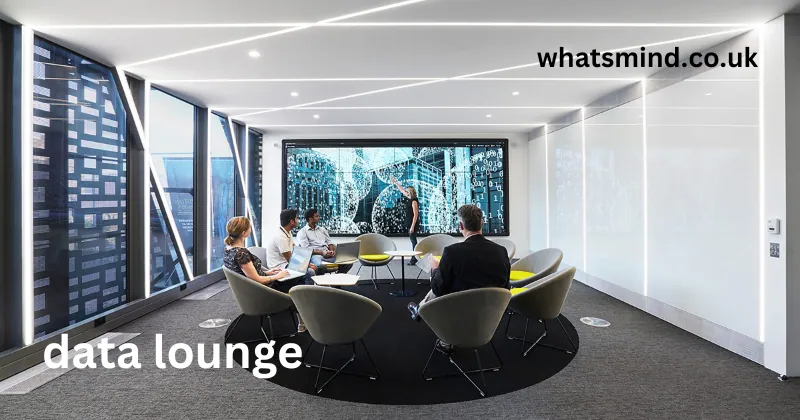Introduction
In today’s fast-paced digital universe, where information flows ceaselessly and data is a key currency, the idea of a “data lounge” is gaining traction. Simply put, a data lounge is a dedicated space or environment where data professionals access, analyze, and share data insights collaboratively. This article aims to delve deeply into the concept of the data lounge, explore its benefits, and examine how it is transforming the landscape of data management and analytics.
What is a Data Lounge?
The term “data lounge” lacks a formal definition in academic literature, but it is often described as a collaborative space for data professionals—data scientists, analysts, engineers, and business intelligence experts—to come together and work on data-centric projects. Much like a physical lounge designed for relaxing and informal discussions, a data lounge fosters a culture of openness and creativity, allowing individuals to share insights, brainstorm ideas, and solve complex data problems in real time.
In practice, data lounges can take various forms: from physical office spaces equipped with state-of-the-art technology and interactive data dashboards to virtual platforms designed for remote collaboration. The core premise remains the same: to create an environment that promotes data-driven decision-making and nurtures teamwork among diverse professionals.
The Importance of a Data Lounge
Encouraging Collaboration
One of the primary advantages of a data lounge is its ability to facilitate collaboration among team members. Traditional work environments often hinder communication due to siloed departments or rigid hierarchies. A well-designed data lounge encourages an open exchange of ideas, enabling different stakeholders to contribute their unique perspectives and expertise actively.
Teams in data lounges can work on joint projects, participate in design thinking sessions, or conduct brainstorming exercises. This collaborative spirit not only leads to better insights and enhanced decision-making but also fosters a culture of innovation.
Providing Access to Resources
Data lounges are typically equipped with the tools and technologies necessary for effective data analysis. This includes data visualization software, programming environments, and access to vast data repositories. By centralizing these resources in one location—both physical and digital—data lounges ensure that all team members have equal access to the information needed to perform their tasks effectively.
Promoting Continuous Learning
In the ever-evolving landscape of data analytics, continuously upgrading skills and knowledge is essential. Data lounges can serve as hubs for training and professional development, offering workshops, seminars, and informal learning sessions. This setting fosters a culture of continuous learning, enabling professionals to stay updated with the latest tools, techniques, and industry trends.
Enhancing Creativity
Creativity is a crucial component of data analysis. In a data lounge, the relaxed atmosphere helps to lessen the pressure typically associated with data work, thus allowing professionals to think outside the box. By providing a comfortable environment that encourages risk-taking and experimentation, data lounges can lead to innovative solutions and transformative insights.
Key Features of a Data Lounge
While the specifics of a data lounge may vary, certain key features are common across successful implementations:
- Open Layout:
An open layout promotes interaction and collaboration. Flexible seating arrangements, brainstorming areas, and collaborative workstations encourage teamwork and make sharing ideas easier. - Technology Integration:
High-speed internet, multiple screens for data visualization, and access to cloud-based analytics tools are essential for effective operations in a data lounge. - Data Dashboards:
Real-time data dashboards that display key metrics and insights can keep teams informed and engaged while providing instant access to important data for decision-making. - Social Spaces:
Incorporating social elements such as coffee bars, lounges, or recreational areas fosters informal interactions, enabling team members to build relationships and discuss ideas in a relaxed setting. - Training and Resource Areas:
Dedicated spaces for workshops, training sessions, and resource libraries ensure that the team is equipped with the knowledge and tools necessary for successful data initiatives.
Implementing a Data Lounge in Your Organization
Assess Your Needs
Before establishing a data lounge, evaluate your team’s specific needs. Consider the types of projects they work on, their current collaboration tools, and any barriers to effective communication. This assessment will inform decisions about layout, technology, and resources.
Create an Inclusive Environment
Simulate inclusivity by redefining workspace structures and ensuring participation from diverse roles within the organization. Invite data professionals from different departments—sales, marketing, operations, etc.—to participate in the data lounge to create a rich exchange of ideas.
Invest in Technology
To support a data lounge, invest in necessary technologies that will allow your team to communicate effectively, analyze data, and present insights easily. Cloud-based analytics tools, data visualization software, and collaborative platforms are critical.
Foster a Culture of Collaboration
A data lounge is most effective when the culture within it prioritizes collaboration and knowledge-sharing. Encourage transparency and make tools available for all to access previous projects, insights, and methodologies.
FAQs About Data Lounges
1. What is the primary purpose of a data lounge?
The primary purpose of a data lounge is to create an environment where data professionals can collaborate, share insights, and analyze data together, fostering a culture of innovation and learning.
2. How can organizations benefit from implementing a data lounge?
Organizations can benefit from enhanced collaboration, improved access to resources, continuous learning opportunities, and increased creativity, which ultimately leads to better data-driven decision-making.
3. Are data lounges only for data scientists?
No, data lounges are designed to include all data-driven roles, including business analysts, data engineers, and even non-technical stakeholders from various departments, promoting cross-functional collaboration.
4. Can data lounges be virtual?
Yes, data lounges can also exist as virtual spaces using collaborative platforms, enabling remote teams to work together effectively, share insights, and analyze data.
5. What tools are typically found in a data lounge?
Tools often include data visualization software, cloud-based analytics platforms, collaborative communication apps, and resources for training and professional development.
Conclusion
The concept of a data lounge represents a significant evolution in how data professionals interact, collaborate, and innovate. By breaking down silos and fostering an inclusive, resource-rich environment, organizations can harness the full potential of their data analysis capabilities. As companies increasingly recognize the importance of data-driven decision-making, the data lounge will likely become a cornerstone of data strategy. Embracing this model may be the key to not only staying competitive in today’s fast-paced business world but also fostering a culture of creativity and innovation that drives growth and success.



